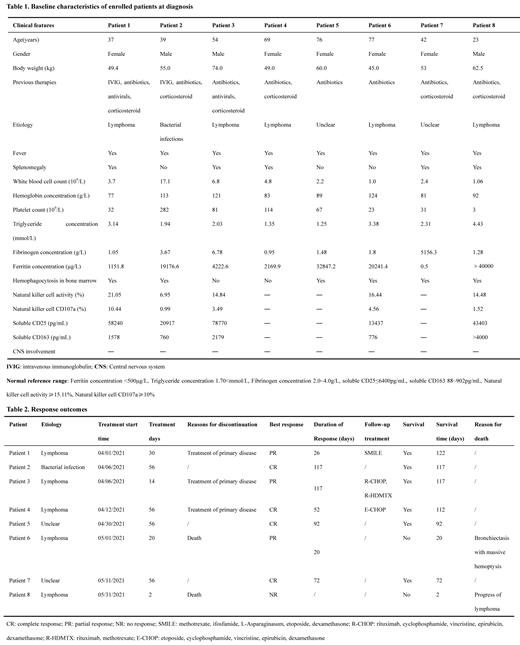Abstract

Background
Hemophagocytic lymphohistiocytosis (HLH) is a cytokine-driven inflammatory syndrome associated with hereditary or acquired immune-dysregulation. The frontline therapy for secondary HLH in adult patients is HLH-1994 regimen, however overall survival of these patients remains suboptimal. Janus family kinases JAK1 and JAK2 are hallmarks of the final common pathway in HLH, and ruxolitinib (an oral JAK inhibitor) has shown favorable efficacy and safety in murine models and clinical trials. Recently, Lauren K. Meyer et al demonstrate that hypercytokinemia of HLH reduces the apoptotic potential of CD8 T cells leading to relative dexamethasone resistance, and this apoptotic potential is restored both in vitro and vivo when exposure to ruxolitinib. This finding provide rationale for combining dexamethasone and ruxolitinib to enhance the lymphotoxic effects of dexamethasone and thus improve the outcomes for patients with HLH. We were very interested in this finding and conducted this pilot trial in adult patients with secondary HLH.
Methods
We managed 8 newly diagnosed HLH patients with ruxolitinib combined with dexamethasone or methylprednisolone from April 1, 2021 to May 31, 2021 in the First Affiliated Hospital of Medical School of Zhejiang University. All patients fulfilled at least five of the eight HLH-2004 diagnostic criteria and the etiology was not identified at the time. The regimen in detail was ruxolitinib 15mg po. bid d1-56, dexamethasone 10mg/m 2 d1-14, 5mg/ m 2 d15-28, 2.5 mg/m 2 d29-42, 1.25mg/m 2 d43-49, reduce the dosage until withdrawal d50-56 (For patients with liver insufficiency, dexamethasone is replaced with the same equivalent of methylprednisolone). Once the patient's primary cause had been identified, we wound begin primary disease treatment immediately.
Results
Eight newly diagnosed HLH patients without previous treatment were enrolled in this study with a median follow-up of 102 (2-122) days, including 5 cases of lymphoma-associated HLH, one case of bacterial infections-associated HLH, and 2 cases of unknown etiology. The overall response rate at the end of HLH treatment was 87.5% (7/8), with 50% (4/8) in complete response (CR), 37.5% (3/8) in partial response (PR), and 12.5% (1/8) in no response. Among the patients achieving CR, 100% (4/4) maintained CR condition for>2 months. 2-month overall survival was 75% (6/8), one patient was dead because of lymphoma associated HLH progression, another patient was dead because of bronchiectasis with massive hemoptysis after the HLH was under control. For the lymphoma-associated HLH subgroup, 4 of 5 patients responded to ruxolitinib combined with dexamethasone, three patients successfully bridged to chemotherapy after diagnosis of lymphoma; One patient defused to chemotherapy because she was 77 years old and had severe bronchiectasis; the patient with NR was dead in 2 days due to the rapid progression of disease. No treatment-related deaths were observed.
Conclusions
In our trial, ruxolitinib combined with dexamethasone regimen initially demonstrated favorable efficacy in newly diagnosed adult patients with secondary HLH. Especially for patients with lymphoma-associated hemophagocytic syndrome, it is an efficient and safe bridging therapy while waiting for pathological diagnosis. This novel treaiment is promising, and should be evaluated in larger sample size studies.
No relevant conflicts of interest to declare.
Author notes
 This icon denotes a clinically relevant abstract
This icon denotes a clinically relevant abstract


This feature is available to Subscribers Only
Sign In or Create an Account Close Modal